FAQs on the Molly Health/Disease
10
Related Articles: Mollies, &
Poeciliids: Guppies, Platies,
Swordtails, Mollies by Neale Monks,
Livebearing Fishes by Bob
Fenner,
FAQs on Molly Disease:
Molly Disease 1,
Molly Disease 2,
Molly Disease 3,
Molly Disease 4,
Molly Disease 5,
Molly Health 6,
Molly Health 7,
Molly Health 8,
Molly Health 9,
Molly Health 11,
FAQs on Molly Disease by Category:
Nutritional (e.g. HLLE),
Social, Infectious (Virus, Bacterial, Fungal),
Parasitic (Ich, Velvet...),
Genetic, Treatments
FAQs on Molly Reproduction/Breeding:
Molly Reproduction
1, Molly Reproduction 2,
Molly Reproduction 3,
|
|
|
Female white molly lost activeness
10/21/18
I'm watching her for 3 to 4 days she lost her activeness. Then I think she is
pregnant but here you can see a pic one green spot reflecting from her body.
<... Mollies are perennially (always) pregnant to degrees... What re your water
quality? This fish/species needs hard, alkaline water, a modicum of salt... no
ammonia or nitrite. I would not be especially, directly
concerned re this green spot. DO read on WWM:
http://www.wetwebmedia.com/fwsubwebindex/mollies.htm
and the linked files above. Bob Fenner>
Re: Female white molly lost activeness 10/21/18
Please help me out to make my white molly more healthy.
<Read on! BobF>
|
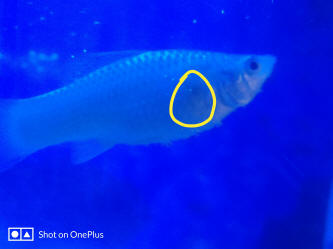 |
Treated fish 7/3/18
I bought some Molly’s from a pet store, when I got them home two of them
sank to the bottom of the tank. They appeared sick. I put them in their
own sick tank and treated them. 3 days later and are acting “ normal “
and eating. When should/can I return them to the community tank?
Thank You
Denise Copper
<Mmm; good that you were so readily reactive. Your mollies likely need
hard, alkaline water conditions with a modicum of salt, moderate
temperature. What about your other livestock? Community organisms need
to have an "agreeable" overlapping range of provided environment...
without such, there will be trouble.
Please read over Neale's article re the genus Mollienesia here:
http://www.wetwebmedia.com/fwsubwebindex/mollies.htm
And write back if your path is nor clear. Bob Fenner>
|
Molly coloring or ich? 12/6/17
Hi Crew,
I bought a couple of mollies today at my LFS. I was thinking it was natural
coloring for a molly but now I am hoping it's not ich. I attached 3 best pics
they are not great pics but they are the best I took of around 10 hopefully you
can tell me if my fish have problems. Thanks in advance Joe
<I can't make out if this fish has Ich or not Joe. That it is full-bodied and
has erect finnage, is out swimming are good signs. Is the water here alkaline,
hard... are you using aquarium salt? I would ask you to read re Mollies on WWM,
starting here:
http://www.wetwebmedia.com/fwsubwebindex/mollies.htm
and as much of the Molly FAQs files linked at top that you have time for. Bob
Fenner>
|
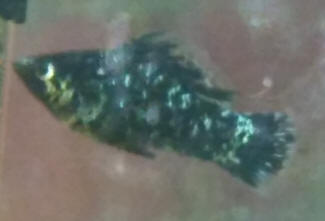 |
|
Re: Molly coloring or ich?
12/7/17
Thank you for the reply Mr. Fenner
I am not using aquarium salt. Should I be?
<Mmm; IF the other life here can tolerate it... yes>
and if yes on what type of schedule?
<... please read where I referred you>
My tank is a 40 gallon long. One of my fish is a black ghost I know that is
eventually going to be to small but I took him from a friend in a pinch that
took down his tank. My other fish are blood fin tetras and Cory cats.
I thought I read somewhere that black ghosts can't do aquarium salt I know you
will clarify that for me.
<The Tetras and likely the Corydoras are not fans of much salt... Better to
place the mollies elsewhere if you have another cooler water, higher pH, dKH
system>
Also I know you said you can't tell by the photos that it is ich BUT is black
with white spots ever a common pattern on a molly?
<Mmm, yes... there are actual "Salt and Pepper" varieties>
You mentioned that
<...That it is full-bodied and has erect finnage, is out swimming are good
signs>... I am taking it that you mean "good signs" as to the possible health of
the fish and not "good signs" that is probably is ich.
take care. Joe Kerner
<Likely this fish is fine; would be better in a tank w/ conditions that
favor it. Bob Fenner>
|
|
Older Molly Fish in crisis questions
5/4/17
<Dave; 11 megs of pix... Ughh mate; we ask that folks limit....>
Aloha and thanks so much for being willing to offer thoughtful advice to people
caring for animals they love.
<A hu'i hou!>
I'm writing about Hilton, the fish I've had the longest, acquired as a
centimeter-long speck of silver from an outdoor lagoon next to the ocean at the
Hilton Hawaiian Village in December 2014. I estimate she was born in early
December 2014.
<Oh! headed out that A Bay way next week>
Several photos, including a recent one, are attached. I suspect from research
that she is a Molly fish of some kind, considering where she was born; perhaps
you can make a concrete ID.
<Mmm; at one time this molly (non-indigenous) was considered Poecilia sphenops
Valenciennes in Cuvier and Valenciennes, 1846... now a hybrid>
She very briefly lived in a brackish water container before spending the rest of
her life, until now, in a freshwater 10 gallon tank, no salt added, with no
health problems until earlier this year, as she edged into her third year of
life.
Early in 2017 I noticed a small white fuzzy patch on the side of her tail; soon
thereafter I spotted a similar small patch on the edge of her tail.
The "Hilton May 2" photo shows the erosion that second patch caused.
<See this>
She was quarantined along with a male also acquired in the same place in May
2015, though he had no symptoms (I did this so she'd have some
company/normalcy). First she received Furan-2 for a four day treatment.
<Mmm; is the system water hard and alkaline? I'd make sure and likely add salt
per Neale (Monks) input on WWM>
When the patches disappeared, they went back to her home tank, only to have a
spot on her right side near the dorsal fin develop a small wound of some kind,
and another fuzzy spot develop on the left side of her tail. She and the male
returned to the hospital tank, and underwent an 8-day Furan-2 treatment. At that
point I decided she would live permanently in this tank so I could provide
further care if needed. While the fuzzy patches went away, they first sort of
turned blackish, the erosion on the edge of her tail slowly continued. Soon, she
developed a disinterest in eating, not
swimming away from the bottom of the tank, and at that time underwent a further
Furan-2 treatment. Poco was removed to the home tank, as he often attempts to
mate with her, and that seems to be a stressing her. Following the subsequent
Furan-2 treatment, she has continued to refuse to eat. I began researching
things to try and cure the illness and make her comfortable, and started salting
her water for the first time. It is - I assume - marine salt, since it was
bought from a fish store sometime ago, in a 3 pound bag and otherwise unmarked;
cost maybe $3-4?
<Can't tell from here>
Something like that. I started using about a teaspoon of it per gallon in her
3-gallon hospital tank and have bumped it up to about a tablespoon. She also
went through a five-day medication of Jungle Lifeguard, before another round of
Furan-2, all with her water salted. There is such conflicting information as to
the amount of salt I should put in each gallon of her water to try and heal her;
that is one thing I could use advice on.
<... See, as in read... WWM>
Bittersweet, the wound on her side has healed a great deal recently; it has no
fuzz, appears much smaller (evidenced in the May 2 shot) and there is none
elsewhere on her; the spots where there had previously been white patches on her
tail have a slight blackness to them; there are no current white fuzzy patches
visible, even with a magnifying lens.
After folks at a pet store viewed a recent video from April 22
https://www.youtube.com/edit?o=U&video_id=qDDl3lgi2vc , they suspected it
was a fungus and recommended API Fungus Cure, which she started yesterday, now
on day two. May 1 I shot a second video
https://www.youtube.com/edit?o=U&video_id=qgs5js9D9GI.
<This issue is baseline environmental. No sense treating w/o fixing the water
quality>
I am extremely concerned at her lack of eating. It is at least three weeks.
There is a small amount of Anacharis and a moss ball in her hospital tank which
the pet store folks said was a good thing. I've attempted to coat algae pellets
(among her favorite foods) with garlic (including Garlic Guard), tried other
bottom feeder pellets, peas, frozen bloodworms, live brine shrimp... all to no
avail. Freeze dried worms are her favorite, but she won't leave the bottom.
Any suggestions you have regarding what I can or should do, I would greatly
appreciate. In two years of fishkeeping, this is the first encounter with
something like this, and I love her very much. If there is a way to save her
that I can manage, I will try. Forgive my long email.
Thanks so much and I apologize for all my apparent shortcomings as a fish
keeper.
Dave Lawrence
<Water quality measures please, including temperature. Bob Fenner>
|
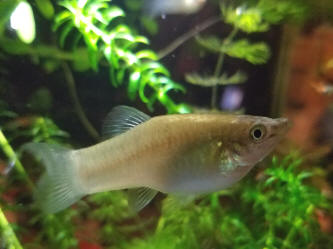
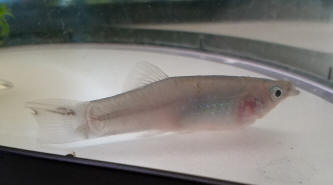 |
|
Re: Older Molly Fish in crisis questions
5/4/17
I am so sorry about the large image file sizes. Forgive me, and am so grateful
for your help and speedy reply. God bless you guys. I will reduce sizes anytime
in the future.
<Ah, thank you>
So she is a Molly; thanks for the details. I've never seen anyone with her shape
in a pet store, or really in photos online, so it's always been sort of a
mystery, until now.
<Oh, there are quite a few species and many sports, hybrids of
Mollienesia/Poecilia... Do a quick Google search re the genera, common name>
The water is tested with Tetra test strips (I will buy an expensive liquid test
kit after reading about the strips), and they report the water is hard to very
hard, with low to moderate alkalinity 40 - 80ppm KH , at the lowest level of
nitrates and nitrites (nitrates always kept at the 0 or far left pad color, and
nitrites at zero or up to .5 or the second pad on the left, at which point I
make a water change with same-temperature pre-dechlorinated water).
<Ahh; need to improve, increase biological filtration and/or decrease the amount
of food/wastes being processed. There must be NO nitrite or ammonia present>
How could I increase the alkalinity?
<There are a few ways/means; the safest, easiest is to add a bit of baking soda
(sodium bicarbonate) to the new, change water... when you do tank
maintenance every week. Read here:
http://www.wetwebmedia.com/fwsubwebindex/fwh2oquality.htm
The temperature is 74 in 24 hour AC apartment. The heaters I've seen available
nearby raise the temp to a potential 78, +/- 2 degrees.
In terms of the salt level, I've read so many posts with so much detail
it's hard to find a direction for how much I should use; is 1
tablespoon per gallon appropriate to create a healing environment, or if not,
how much, preferably using teaspoons or tablespoons for measuring?
<I would JUST read, follow Neale's pc...
http://www.wetwebmedia.com/fwsubwebindex/SaltUseFWArtNeale.htm
How long can she live without eating and what would you recommend I do next?
<Read, then act... B>
Thank you again.
Dave
|
Re: Older Molly Fish in crisis questions
5/5/17
Mahalo, Bob, so much. It can be overwhelming searching your vast material,
so those direct links are great. I got the sodium bicarbonate for raising
the KH (for her 3 gallon tank
<Do take care... such small volumes shift very easily in terms of water
quality... >
that is just a dusting in a teaspoon-- Like barely anything in it,
correct?).
<Pre-mix in other water... change out the water itself Dave>
Fresh photos are attached as well, just taken tonight, and low file sizes.
She is going into her fourth day of her 4-day API Fungus Cure treatment
which started Tuesday at 10am, and ends Saturday at 10am. Hilton has not
eaten since at least April 10. It has been a very upsetting time since then
so I really, really appreciate help.
<Sure>
What do you recommend I do after the API Fungus Cure treatment ends Saturday
morning, if she is still with us?
<I would move this fish back to a larger main/display system. Too stressful,
toxic in a small one>
If you think I should not be continuing with that or that I should be
modifying her treatment in some way now, please advise. Saturday morning,
per the Fungus Care package instructions, I will be putting in a fresh new
carbon filter cartridge, and changing at least 25% of the water, unless you
thought differently.
<You may need to change a good deal of the water here daily, every other
day. DO measure for ammonia>
Her 3 gallon tank has, for the past few weeks, had gradually increased salt
in the water, and I read the article by Neale, thanks again, including
measurement details to conduct the heavy (not recommended) anti-fungus
treatment; but looking at her and her case, what would you advise as a level
of salt for her water going forward from Saturday morning, in teaspoon
measurement?
<Per Neale's work, some middling value to accommodate all life kept>
In the tank, there is Anacharis/elodea held down by a small metal
plant weight,
<Ahh! Yikes. Get rid of the lead. Pb is toxic to all; including the
plant/s!>
a small moss ball, a Tetra filter sleeve with some substrate and a shell
from her home tank in it... and that's it. Plus the airstone cranking air
and the filter (now there are two foam filters in the carbon's place during
the treatment). Tell me if more plants, less plants is better. The tank is
bare as you can see; I baster out every object, and try to leave her food in
there for only a few minutes each time, before getting it out of there and
any crumbs.
<Good>
The areas that previously had the white fuzzy patches have now turned black;
does this reveal anything to you?
<Yes; generally a good sign... healing>
As you can see in the pics, the areas on the tail that previously had the
white fuzz have this black and there's no fuzz; also an area on her face has
gotten the black marking in just the last 24 hours, on the left side; is
that a sign of the treatment working and it is dead skin or something worse?
<The former>
I imagine you've seen this before, and this reveals something to you about
the nature of what illness she has; is it a fungus or do you think
you have a diagnosis on what I am battling?
<Was, is environmental more than pathogenic. Perhaps a read here:
http://www.wetwebmedia.com/mardisease.htm
Since you IDed the species, do you know the lifespan?
<A few years... to a handful>
I am curious if this is a part of her being old...
<Could well be>
I'm buying the API master test kit Saturday; her test strip tonight said 40
ppm on nitrate, 0 on nitrite, 150 or hard / close to very hard color 300, 40
on total alkalinity, between the 7.8 and 8.4 on ph. Can ammonia still be
present if nitrites are 0 (pad totally white)?
<Yes>
Otherwise I wondered how during the day the nitrates went up so much.
<Measure the new water, change out half and check 24 hours later...>
if there's anything else, any medicine, or anything you think I should/could
buy that would help, or direction on follow-up to the Fungus Care treatment
starting Saturday morning (or a change before then), I'm so grateful for.
<Really; just improved environment... nutrition of a good deal of greens
content (I really like Spectrum pellets)...>
Dave Lawrence
Honolulu Host, All Things Considered
Hawaii Public Radio
<Oh, I listen to this show/segment on KPBS here in San Diego on 89.5. Bob
Fenner>
|
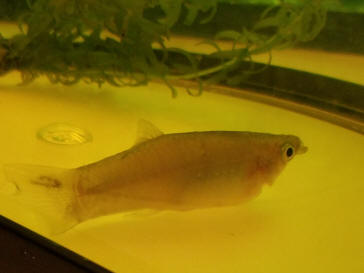 |
|
Re: Older Molly Fish in crisis questions
5/6/17
Thanks so much, again Bob. Distilled questions/comments for easier response
here:
A.) I will be very careful and pre-mix the sodium bicarbonate in what will be
new tank water.
<Good>
B.) On returning her to her main tank, her mate and some Endler's males are in
there; they will pick at her; she is vulnerable and it will cause stress. In her
state, I don't think she could continue to heal with fish that are harassing
her; she is largely calm and secure from that where she is. I don't think she is
strong enough to take it yet. She would be a sitting duck. When she first went
into this hospital tank, she ate regularly through her first two Furan-2
treatments and was very relaxed.
After moving her mate Poco out, I briefly reintroduced him to see if it would be
positive for her, and he was a complete a-hole, trying to nip and behaving as
Mollies (and Endler's) typically do toward vulnerable fish. He was out in under
20 minutes.
<Rats! Any way to add more decor, break up the environment... confuse the
present status quo/dynamic that might allow her return? Another system?>
C.) So in lieu of moving her, am I reading from your comments that I should
change 50% of the water Saturday morning, when I put a new carbon filter in?
<I'd only change these out every few weeks... the carbon does what it does...
and bio-filtration added/established is better>
D.) I do measurements daily as is and Saturday will have the kit, as well as the
spectrum pellets if available at the store. What else can I do to improve her
current tank environment?
<Mmm; nothing really>
E.) I will remove the plant weight. Any suggestion how to keep plants down
safely?
<Let them float is better... See WWM re Egeria/Anacharis....>
F.) On the salt levels for her, forgive me but I don't know how to employ the
"middling value to accommodate all life" thing; should she be receiving salted
water, and what amount, in teaspoons or tablespoons, should I provide per gallon
when I do the water change tomorrow/Saturday morning? I will mix it before
adding.
<A level tsp. per the system... half for half of it>
G.) Are there any other medicines, water additives or products I should buy
tomorrow?
<None recommended. More harmful potentially than useful>
H.) Are any plants valuable for her to have in there to make it a better
environment? I have some hornwort, like the lily pad-looking plant with light
green in the left center of this stock photo; fox tail... some others I don't
know the name of, all in her main tank, which I could move to her hospital tank.
Or I could buy some at the store...
<The Elodea/Anacharis you have is ideal, as well as the Ceratophyllum mentioned>
Thanks so much Bob. I'm trying my best and am grateful for your expertise.
<Glad to have a conscientious, compassionate person on your end. Bob Fenner>
Fwd: Older Molly Fish in crisis questions 5/6/17
Sorry. Forgot to attach this stock photo I refer to in line H, Bob. Forgive me.
<Ah, no worries. B>
|
.jpg) |
|
Re: Older Molly Fish in crisis questions
5/6/17
Aloha Bob,
So sorry for the delay in replying; trying to work and it's a bear of a day.
<No worries Dave>
I don't think I can put her back in her home tank due to nowhere to put the
other fish that will peck at her. Right now, she is sitting on the bottom of the
hospital tank, not having eaten since at least April 10, so I just don't think
she is strong enough to be in there being harassed as opposed to recovering with
peace and security, despite the smaller space. I know it sucks, but in the 3
gallon she has no one to bother her, and I will have to try to make her
comfortable in there. I will change the water as much as you suggest each day,
starting Saturday/tomorrow.
1.) With that unfortunate reality in mind, relating to tomorrow morning when the
Fungus Care treatment is officially finished, what should I do for her water? I
didn't understand your comment below that said <I'd only
change these out every few weeks... the carbon does what it does... and
bio-filtration added/established is better> Does this mean don't do a 50% water
change, and stick to the directions that call for a 25% water change?
<The 25% is best>
Also, the directions say return to a fresh carbon filter. I can use a fresh one,
or the one she last had in there before the treatment, which was only a couple
weeks old. I can also add the current sponge filter to that, if
you think it would be beneficial. Again, there is also a Tetra filter cartridge
sleeve filled with substrate from her home tank sitting in there, too. Please
tell me which filter cartridge to use, and if any shells, rocks or other objects
could be beneficial for her in the 3 gallon.
<Wait another couple weeks on changing any/all>
2.) I will remove the plant weight and let the Anacharis float, plus will try to
find the entry on your site you refer to below about plants.
3.) On salt, to be clear, are you saying I should put 1 level teaspoon in of
salt for the entire 3 gallon tank, or if changing half the water, half a
teaspoon for the entire 3 gallon tank?
<One level tsp. for the entire volume; part for part>
4.) Per your advice, she will not receive further medicine but I will get the
spectrum pellets, and any other food you advise. I will continue to try enticing
her with algae pellets and the frozen bloodworms, both alternately
dipped in garlic guard (and all of it cleaned out after she ignores them).
5.) I can add the fox tail Ceratophyllum and also the lily pad-looking plant in
this attached photo, the plant in question is immediately to the right of
Hilton's head in the shot; I have plenty of that, the fox tail, and the
Anacharis. Should I add all of these to her 3 gallon?
<If there's room; yes>
Any advice on how much of them to add, should they all be allowed to float, and
should I buy any more of these or other plants at the store tomorrow, or any
better contraptions to hold them down?
<... let them float>
I could buy her a little house or cave of some kind, too, if you think it would
help her.
6.) After the initial water change (which I asked for directions on above), what
should I do each subsequent day in terms
<... weekly changes unless there are water quality issues... known from testing>
I am so sorry for all the questions. Forgive me. I value her like a child; I
have no children, and will never buy another fish or capture a wild one like I
did with her, I am so traumatized by this situation.
<Yikes>
I cry every day about it, Bob. However, I seriously doubt she would ever have
lived this long in the Hilton Hawaiian Village lagoon. So she has had a great
life, and still is very lively. God bless you for shepherding my
dear little friend and her terrified keeper through this. You are doing a huge
service for good in this world.
dl
<I REALLY like the anchialine ponds there and all along the Kona coast... and
the life in them.
Be of good cheer Dave; you're doing all that can be done. Bob Fenner>
|
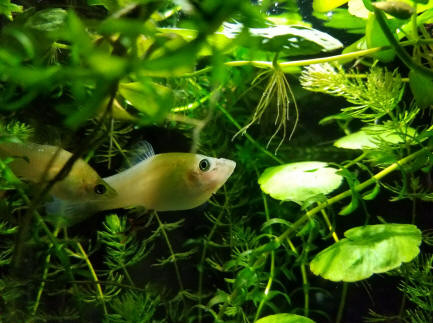 |
|
Re: Older Molly Fish in crisis questions
5/8/17
Aloha Bob,
Yesterday I got: API master freshwater test kit, New Life Spectrum Algae
Max, plastic food clips, and a small ceramic house.
<Progress!>
Her previous carbon filter cartridge was not available, so I used a new one
(these are Tetra small carbon filter cartridges). In place of carbon filter
during treatment, there were two filter inserts; one made of material not
unlike the Tetra "bio-bag" material (which I removed), and the other a foam
one (I rinsed off in home tank water and returned to her hospital tank
filter, along with the new carbon cartridge).
I conducted a 25% water change with clean room temp dechlorinated water,
though due to coming off her four-day Fungus Cure treatment, tank water
level was slightly low, so in all, she received about 2/3 of a gallon of
this water (to her 3 gallon hospital tank).
Several hours later, I added a single teaspoon of salt, first mixed into
about 8 oz. of her tank water and slowly/widely dispersed into her tank.
She soon began moving about frantically, swimming to the top and looking
very animated or conceivably distressed, so in caution I was hurting her, I
extracted one gallon of water quickly, put in a gallon of fresh regular
dechlorinated water, and she settled down immediately and was again
completely relaxed. I keep many gallons of dechlorinated water at room
temp/same as tank temp on hand and they always get water at the same temp
they are in.
<Good>
She has plants you suggested and a snippet of one other around and floating
above. Food clips, though made for holding seaweed and other vegetables at
meals, also work well to gently grasp/hold plants, so Hilton can have them
on the bottom, a nearby roof of living greenery; she loved sitting under
floating plants in her home tank. I hope you think that was a reasonable way
to remove the metal plant weights, while still keeping nice living
plants close around her down there. She never was much for logs or hiding
places, though occasionally did sit in a log, so I got a small ceramic one
at the store, both as familiar decor and a potential place for
privacy/exploration, and, it holds down another few snippets of the same
plants.
<Fine>
She didn't eat the food during multiple feeding attempts, but thanks for
turning me onto it. The home tank crew had it for dinner, and ate it
eagerly. Should it be refrigerated for freshness?
<This is best; yes>
Test results: I did it yesterday and today. Yesterday was done a few hours
after the initial water changes and before the incident with the salt, and
were: ph 7.6, high ph between 7.8 - 8.0, ammonia .25ppm* (though keeping in
mind the tank dyed water color following the API Fungus Cure was the exact
same light fluorescent green color as the chart), nitrite 0ppm, nitrate
5.0ppm or less. Today, the test was nearly identical; the ammonia reading
has no tint of green, it is a lighter yellow than the card provided, so one
could either say it's either 0 somewhere leading to .25ppm in closest match.
It definitely is not the strong/darker yellow that the 0ppm is on the chart,
but has no tint of green. Tank water color is much less dyed green now, too.
Any advice on pulling down that ammonia or if the other numbers need to be
adjusted is appreciated.
<All good here>
Thanks so much for the guidance and forgive my errors. I also do believe she
is simply at the end of her life and nothing will get her to eat. Do you
think 2 1/2 years is normal for a fish like her?
<Is about the regular lifespan, yes>
Living in that lagoon she'd never have lived until this age, I am convinced.
They drain that thing constantly and condition it so people can swim in it,
exposing the water to who knows what with sunscreen, etc. I love her.
Dave
<Be of good life Dave. BobF>
|
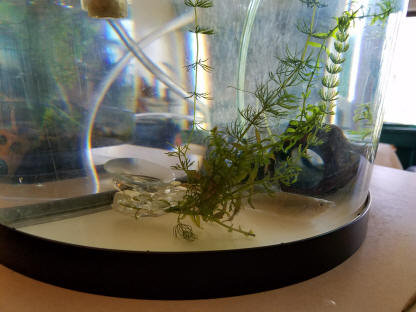 |
Re: Older Molly Fish in crisis questions
5/10/17
Aloha Bob,
Hilton passed last night. I was there, thankfully. Moments after I got home,
too, like my Mom in Heaven had her wait until I could be there. Very heavy.
<Ahh>
Thanks for all your advice and assistance in caring for her. I'm quite grateful.
<Glad to assist you Dave>
I am trying to carefully monitor her home 10-gallon tank to prevent a fin rot /
Saprolegnia or whatever it is outbreak from occurring.
<Mmm; true fungal (many such labeled are actually bacterial) infections are
actually quite rare; mostly very challenged fishes and/or poor environments are
involved>
My Corydoras paleatus looks fine, but sometimes it's hard to tell if there is
any growth on him due to his coloration and the way light affects it, so, since
Hilton had lived in there, I have extensively cleaned it to remove decaying
organic matter and any waste, including about 50% water changes each day since
last Wednesday. Always same temp conditioned water.
Also removed some of the plants that created waste. From what I read the
Saprolegnia and fin rot can be brought on by excessive decaying organic waste,
including leaves, etc. from plants.
Stats in water are solid: high ph 7.4 - 7.8, 0ppm ammonia, 0ppm nitrites, 10 -
20 ppm nitrates.
<Fine>
Any recommendations to ensure fin rot doesn't spread in there?
<Keep doing what you're doing... water changes and staying vigilant>
A big heartfelt mahalo. Sad days here. God bless you.
dl
<Cheers my friend. BobF>
Re: Older Molly Fish in crisis questions
5/12/17
Thankful for your help, Bob. In terms of trying to assist in preventing
anything spreading, would 1 tablespoon of salt for this 10 gallon be
good to add for this situation, with a Corydoras paleatus, Synodontis
petricola, Otocinclus, and a beloved apple snail?
<As long as your water quality is fine, I would leave off w/ the salt
addition here. Of the fishes you list, none appreciate more salt
(combinations of metals and non-metals)>
I heard it could be beneficial in preventing any illness spreading, but
wanted to make sure it won't hurt the cats.
<... there is quite a bit to relate re "adding salt/s" issues. Again, I
would not do so... though the source water here has little dissolved
solids (including salts)... am out/up in Waikoloa presently... the ponds
about A Bay were about filled in from the storm a few years back. Am
hoping the ones near Kaloko fared better>
I am doing a 50% water change daily, room temp water (74/75) / same as
tank, all stats are solid (0 ammonia, 0 nitrites, 10-20 ppm nitrates,
7.4 - 8.0 ph), so would I add the salt after one of those water changes
and just do it once? Thanks. No sign of anything but some of the
Synodontis bar bells are a bright white. Also could be I never examined
them this closely too. No white fuzz or patches I can see. Thanks so
much. Be safe bro. Dave
<Maybe read Neale's short treatise here:
http://www.wetwebmedia.com/fwsubwebindex/SaltUseFWArtNeale.htm
Cheers, Bob Fenner>
|
|
molly sick? Env., worm.... 2/22/17
Hi my name is Steve.
<Kbytes, not Megs Steve>
. I have a 37 gal tank which I started from brand new in a new hobby .. and
of course I made the rookie mistake of adding too many fish too soon…
eventually all died off due to overstocking and ammonia spikes
<Yikes; toxic; debilitating>
at the end I had a Pleco (was a real trooper through all medications etc.)
and 3 mollies 2 female and 1 male, my other fish had no real symptoms other
then swimming upside down and eventually dying. My remaining mollies were
both pregnant several times but the male was very quick at eating the fry
straight from the oven so to speak! He eventually became lethargic and I
noticed (and through research) he had Camallanus worms and
shortly after the birth of 2 litters of fry the females finally showed signs
of it as well. 30 fry were in the tank and the male and eventually the 2
females passed away, over time only 2 of the fry survived.. eventually as
well the last of my “first” fish the Pleco died of Finrot… since then I have
only added 2 baby Plecos, one I had to put in because another of my tanks
got 2 cold in the garage (supposed to be hospital tank but the heater
couldn’t keep up with weather conditions) so I put the Pleco in the 37 gal.
the tank I have left alone to see if these 2 mollies would survive or show
any sign of the Camallanus it has been 2 months now and they seem to be
doing fine other then the smaller of the 2 mollies always had a real thick
white almost cylindrical something hanging from its anus… I have been
watching it closely and it was hanging out 1/8th to ¼ of an inch from its
body and yet feces was travelling through it.
<Reads like a prolapsed colon. Search this on WWM>
No change at all until this week when I noticed the thick white was now
getting longer and curving and bunching up underneath but not falling off..
today I noticed that the center of the white stuff is red (no sign of
Camallanus) and the outer part of the white looks almost cottony. My
question is .. because I have read that Camallanus reproduce through the
feces of infected fish could this be a sign that the mature Camallanus had
died off with the last of the infected fish and could this be the natural
reproduction cycle of Camallanus as I have read it takes several months to
cycle?
<Possibly; but again, this brings to my mind the poor fish's alimentary
canal protruding out of the cloaca, rotting off>
Sorry about the long winded explanation figured you should know the history
of my tank (failures) again the tank is a 37 gal , bio wheel filter, ph
7.5-8, 0 nitrites, just over 80 nitrate,
<MUCH too high. Please read here:
http://www.wetwebmedia.com/fwsubwebindex/fwnitrates.htm
and the Related FAQs linked above. You need to get this below 20 ppm...
there are ways detailed here to do so>
0 ammonia, 80 degrees F, 120 kH and 120 gH, I know my nitrates are high and
I am doing a 25% water change tonight to help lower it also I am attaching a
few pics of the fish in question..
<Need to crop, spiff and then send>
couldn’t get good focus on the blob but figured it might help. Should I
remove this fish all together to stop the respreads of Camallanus to be on
the safe side or could it be the fishes natural immune system killing off
the parasite?
<How did you treat for the roundworms?>
Since these fry were born in the infected tank my home town supply store
said they could have an increased immunity to Camallanus.
<Mmm; no such thing as far as I'm aware>
Thank you for any advice you can send my way!
<Welcome; steady on; you appear to have a good mind, steadfastness in your
favour. Bob Fenner>
|

|
Re: molly sick? 2/23/17
Hi and thank you for the reply.. the round worms I attempted to treat using a
pig dewormer in small doses soaked into their normal flaked food.
<Likely one of the anthelminthic compounds that are used for fishes...>
. I believe it slowed the growth of the round worms in the tank to allow the
fish time to react to it (and I know this was a long shot) but eventually they
all succumbed to the very hard to get rid of round worm, having no fish in the
tank to supply the worms with a host seemed to be my only course of action and
so far it worked, yay.
<.... Please read here Re Camallanus:
http://www.wetwebmedia.com/fwsubwebindex/fwwormdisf2.htm
As far as my molly in question if you don’t think it could be “the return of the
round worm” then I will leave him alone and hope he gets better.. doesn’t seem
to affect him, he’s swimming eating and acting normal as compared to the other
molly, I resized and cropped the photos.. hopefully these pics will help you and
others determine what is wrong with their fish.
<Mmm; mollies are easily lost... for a few reasons. Try the search tool on WWM
to review. Bob Fenner>
|
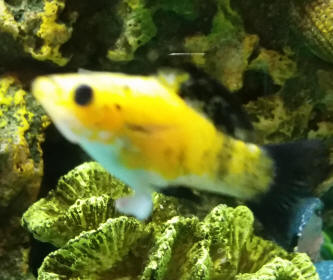 |
|
|
Mollies. Again. 2/14/17
Hi, Neale - long time, no questions! Hope you had a good holiday and that the
new year is treating you well.
<All good; thanks for asking.>
This morning we noticed that we have a silver sailfin Molly that's just
lying on the bottom or swimming lethargically, using only her pectoral
fins. She doesn't use her tail to swim at all. Her tailfin seems kind of
shredded lengthwise, but doesn't look bitten. She had gotten big, we thought she
was pregnant (assuming one of the 7 young mollies is a male), but she seems
slimmer now. We have seen any fry in the tank, though we didn't really look (I'm
only just now thinking of it).
We have another Molly, a creamsicle, that is starting to shimmy.
<Typically a stress reaction, though quite what the stress factor might be isn't
always obvious. Mollies are easily stressed by chilling, nitrate, and the wrong
water chemistry, though like all fish, non-zero ammonia and nitrite are issues
too.>
The numbers are good in the tank - ammonia and nitrite are 0, nitrate is 20.
<Sounds good, but no mention of water chemistry here. Will (re-) state the
importance of carbonate hardness to Mollies; alkaline water with a basic pH is
an essential, especially if salt is not added to the water. Tanks will acidify
between water changes, and this causes problems for Mollies in particular.
Simply doing a substantial water change or three will often help Mollies return
to their normal happy selves. Failing that, adjusting water chemistry slightly,
by the addition of sodium bicarbonate -- one teaspoon per 40 litres/10 US
gallons is a good start. Easiest approach here
is estimate size of tank, make up the correct solution for that volume, and then
add to the tank in small amounts across a few days, giving time for the fish to
adapt. Alternatively, just add the right amount of a given bucket of water (so
might easily be a quarter teaspoon for a 2.5 gallon bucket) and do your water
changes as per normal. I do prefer to keep Mollies in low-end brackish
conditions, but understand that isn't an option in all cases. Read up on the
pros/cons of this, and act accordingly. Would also check the heater, and maybe
turn it up a notch, Mollies preferring quite balmy conditions compared with
standard community tank fare; 28C/82F is not out of line for the bigger, sailfin
varieties in particular.>
Tell me what I forgot to tell you and I'll provide the info, but this is about
it, that I can see. As always, thanks so much for your help!
<Most welcome.>
Tom & Maria
<Cheers, Neale.>
|
 |
|
re: Mollies. Again. 2/14/17
The water is relatively hard, and it goes in at around pH 7.8, then the tank
adjusts up to 8.0 to 8.2 with the bubble stone and stays there. Maria changes
the water weekly at a 25% change. The numbers have all been stable NH3/4,
nitrate, nitrite, pH, etc, for months.
<Understood.>
She's still hanging in there, but in a head up position. Could this be
bacterial?
<Yes, but environment is what you look at first. If you're content that
the tank is good, then sure, treat with an antibiotic. Livebearers are sometimes
given to strange "wasting" diseases after a certain length of time -- whether
old age, dietary shortcomings (do bear in mind they're herbivores in the wild),
social stress, or inbreeding is hard to say. But colonies of livebearers
frequently do well for years, but individual fish may have substantially shorter
lifespans than you might expect.>
Why would the tail separate into lengthwise strips?
<Typically physical damage, such as fighting. Do bear in mind Mollies are prone
to fighting. You could medicate as per Finrot, but keep a close eye on the fish
for evidence of squabbling. Cheers, Neale.>
|
Re: Hello and Thank You 1/24/17
Hello Neal,
Happy New Year.
<Likewise, Maria!>
one of my mollies has swollen, red gills on one side. the other side looks ok. I
change water weekly: ammonium, nitrite are 0. nitrate has never been above
40ppm. what could cause this problem?
<Difficult to say. If just the one side, physical damage is certainly possible.
Fighting, failed predatory attack; getting stuck on a filter inlet; clumsy
handling by a human with a net can all damage the opercula and the gills
underneath them. If the fish is otherwise healthy (in particular: a healthy
weight, nice and active, and not showing signs of things like greyish mucous
patches on the flanks) I'd tend to leave things be. But if alongside other
maladies, might be worth using an antibiotic. Mollies can exhibit "wasting"
symptoms that typically include fin clamping; rocking from side to side ("the
Shimmies"); concave flanks as they lose weight; mucous/pale patches on their
flanks; and a general appearance of
lethargy and disinterest.>
regards, Maria
<Cheers, Neale.>
I don't know... puzzled. Mollies; mysterious passings 10/17/16
Hi, Neale! Got a mystery for you! (maybe)...
<Go on...>
This isn't a question about a specific fish, but rather about a trend.
We've had three male molly fish, including the latest one (a sailfin
silver), that have done the same thing: they'll be doing well, then they
start getting listless, hanging in the water, then they start hanging
vertically either head up or head down. The fish wants to be left alone,
chasing others away. Then starts kind of drifting, unable to fight the
current much, twisting and turning with the water movement. They get
skinny, then weak and then die.
<Does sound like one of the 'wasting diseases' whatever they might be.
Sadly all too common with farmed fish these days. Usually put down to
bacterial infection (Mycobacteria) but who knows? In practise it often
comes down to buying livebearers from a variety of sources, euthanise
any sickly ones, and breed your own generation of healthy specimens from
the survivors. I know that isn't much of a plan, but I have found
home-bred livebearers to be a lot tougher than the ones sold in pet
stores. The problem is that the wasting disease bacteria are prevalent
on fish farms, and little/no attempt is made by farmers to improve the
health of their fish.>
It's just the males. The females are doing great.
<Which is the important bit. They'll be pregnant, almost certainly, so
ensure at least some of their progeny survive, and job done!>
They've done it with fresh water and with brackish water, coolish (78°F)
and warmish (82°F).
<Quite so; while Mycobacteria infections do seem to be exacerbated by
environmental stress, once the fish is actually ailing, the simple
tweaks, like adding salt, don't usually help. On the other hand,
brackish conditions will improve the health of the survivors, making
cross-infection less of a worry, and hopefully when you're a generation
or two in, your Molly collection will be fighting-fit. To give you an
example, the big Guppy and Limia tank in my classroom go through summer
holidays (six weeks!) without food or water changes, surviving purely on
the algae in the tank (it's on a sunny windowsill, so there's a lot of
algae). These are big, hardy, active and colourful Guppies just like
they used to be. They're also a couple generations in from their
store-bought parents. I think that's the solution here: see your
store-bought Mollies as the parents of the ones you're going to keep and
enjoy.>
Again, just the males. The sailfin silver is the third one to do this,
and he started after we salted the water and warmed it up to treat that
one female with a bump (she's fine by the way and we're getting rid of
some of the salt). I don't get it. If sail dies, that'll be it for male
molly fish.
<See above... yes, I agree, but once you start getting fry, keep some of
the males, and I think you'll be fine.>
Have you seen anything like this?
<Many, many times. The tragedy of the tropical fish trade is that
farmers, especially in Asia, breed to a price rather than quality.
Antibiotics and hormones are used liberally, often without anything like
veterinarian control. There's also a focus on bizarre colours and body
shapes that means there's a lot of genetic inbreeding. The result is
that many species that used to be very tough are now flimsy. Guppies,
Mollies, indeed, pretty much all the common livebearers suffer from
this. But you could just as easily mention Angelfish, Dwarf Gouramis and
Ram Cichlids. The list goes on.>
Hope you and yours are well!
Tom
<And likewise yours, Neale.>
|
What does this look like...
10/7/16
Hey, Neale. Hope the autumn is being kind to you - don't know how hot it
gets there, so fall might not be the relief to you that it is to us
after 100°F summer days...
<Well, in England autumn has been pretty mild so far (mid to high 50s in
your money) but last couple days it's been decidedly chilly.>
So we have this, now: a bump on the side of a creamsicle
lyretail Molly female. Honestly this is getting to be more
trouble than it's worth.
<Ah, have I directed you to my article on Mollies before. They can be a
lot of hassle in freshwater systems. Hardier in brackish, even very
low-end brackish. The problem is, I feel, related to nitrate toxicity;
they're much less sensitive to this in situations with appreciable
sodium chloride levels. It also has to be said farmed Mollies are very
poor quality, and I have no doubt that good quality stock is just fine
in hard, clean freshwater systems -- have seen wild Mollies dozens of
miles inland while visiting Belize and Mexico, as well as seeing them
swimming around in mangroves and on offshore islands in fully marine
conditions. So they should be very adaptable. But the farmed, "pretty"
strains... well, let's just say humanity hasn't necessarily brought out
the best in their gene pool.>
We had to euthanize a male lyretail, was wasting away, just hanging, not
eating. Put him in a quarantine tank with salt, fed him algae tabs and
flakes, trying to build him up a bit, but in the end, no...
I'll attach a couple of pictures... Thanks so much, again.
Tom
<This female *might* have a bit of Finrot or fungus, both of which
affect Mollies. Medicating as per these might be worthwhile. But if you
have a quarantine tank, maintaining this/these Mollies for a few weeks
in, say, 25% seawater (8-9 grams marine or non-iodised table salt mix
per litre) might work just as well for a lot less money. If they thrive
in such conditions, that's a clue to what's up here. Mollies are
wonderful fish, very pretty, but a pain in the backside if you're
lumbered with sickly specimens from the get-go. Cheers, Neale.>
|
|
Hit the wrong button. sigh.... The bump is on her right side, just behind
the pectoral fin.
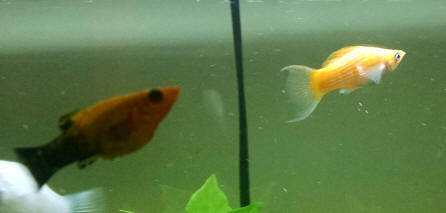 |
|
Re: What does this look like...
10/7/16
Thanks - we're salting the tank to 2gm/liter and bumping the temp up to
84-86°F, and we're going to keep the water brackish if the Pleco will
tolerate it.
<Standard "Common" Plecs (Hypostomus and Pterygoplichthys species) certainly
will; ironically enough these catfish are pests in the brackish streams of
Florida! But Bristlenose Plecs (Ancistrus spp.) will be less happy.>
The bump seems smaller today, it might have just been the result of a bite
from the Pleco, who can be food aggressive.
<Unlikely.>
It might also come back. Who knows.
<Indeed. Good luck, Neale.>
|
And now, weird Molly behavior. Env. 6/17/16
Neale, I hope this finds you well.
<Likewise my reply, Tom.>
We have another problem - we have a Molly that is spending a lot of time
on the bottom. She'll occasionally sort of raise her head and shake it
back and forth and then stop and sit there for a while, until she does
it again.
<Shimmies. Quite common among Mollies, and indeed livebearers generally,
when stressed. Usually, fixing the environment will effect a recovery.
No medications as such required, but if there's something else amiss,
like odd
white patches on the body or sudden loss of weight, then treating as per
a bacterial infection is a good idea. If the only fish in the tank are
Mollies (or other livebearers) then adding salt, 2-3 gram/litre, can
help a great deal.>
She was doing that this morning then started swimming like a maniac,
sometimes stopping and wiggling. The male lyretail did that with her.
Now she's back on the bottom. Ok, Maria just opened the top to get some
water for testing and the Molly was up to the surface in a flash. Her
appetite has been... vigorous this whole time. She just acts funny when
she swims (swims into plant leaves, then backs up and swims around them)
and spends a lot of time just sitting on the bottom in out of the way
places. Poops a lot.
Water numbers:
pH: 7.4 - 7.5
<What sort of hardness level? Mollies appreciate very hard water.>
Ammonia: 0.75
<Still not zero! Mollies are super-sensitive to ammonia and nitrite in
freshwater tanks.>
Nitrates/nitrites: 0
Water gets 25% change weekly, but we haven't been adding bacteria to the
38 gallon tank with water changes.
We just don't know if she's even sick, just acting funny. We had one
Molly with some white spots that got lethargic and died and took another
well-loved fish with her. (We quarantined them, added some conditioner
and PimaFix for fungal infections, and the next morning the pH had
dropped from 7.4 to 5.8. Both fish died.) So we're a little skittish, I
guess.
So there's a lot of info. Any light you can shed on any of it, we'd
appreciate it. Thanks a lot!
Tom
<Hope this helps! Cheers, Neale.>
Re: And now, weird Molly behavior 6/17/16
Good info, as USUAL - thank you so much! Hardness might be a problem. We
have soft water. Would hard water be a problem for the tetras and the
platy?
<Platies will usually thrive in the same conditions as Mollies, though
Mollies do prefer more heat than Platies; Platies are optimally kept
around 22-25C/72-77F whereas Mollies are more 25-28C/77-82F sort of
beasts. But so far as water chemistry goes, both like hard, alkaline,
basic conditions.
Tetras are predominantly soft water fish, with a few exceptions.
Generally not good companions for Mollies because of this. That said, it
will depend on your tetras. X-Ray Tetras, Black Widows, 'False'
Penguins, and Emperor Tetras will all do just fine up to 20 degrees dH,
PH 8, which is fine for Mollies. You can add baking soda, sodium
bicarbonate, to raise hardness. Do read:
http://www.wetwebmedia.com/fwsubwebindex/fwh2oquality.htm
Something like a half teaspoon baking soda per 20 litres/5 US gallons
would be about right. Use a test kit to check before adding any such
water to your aquarium.>
These will likely be the last mollies we get. Sheesh.
<As I've said many times, Mollies really aren't community fish and
shouldn't be sold/bought as such. They are very beautiful, yes, but
quite demanding. Kept on their own though they can look superb! Big
tanks with big groups are wonderful. Check out Liberty Mollies some
time. I saw a group of them in a single-species set up, designed with
lots of flat rocks for them to graze on. Really beautiful fish, and
patriotic too if you happen to live in a country with a red, white and
blue flag! Cheers, Neale.>
Oh, crap... 8/21/16
We got rid of the mollies. But there's still some ammonia in the 38
gallon tank - less than 1, more than 0.5. It looks like a ghost tank.
We've lost two white skirt tetras, and now nobody is swimming.
<But no sign of Whitespot any more?>
Even the 12 neon are sitting towards the bottom in a clump, swimming a
bit, but low in the tank. The remaining white skirts just hang and our
platy is just sitting on the bottom.
<Do lower the water level a bit so there is more splashing. Is the water
moving briskly? Is the water too warm? The fish behaviour could be
related to low oxygen level. Review, and act accordingly.>
The pH is 7.2, no nitrites, a wee trace of nitrates, water is soft,
alkalinity around 80. We have added ammo lock and bacteria. I'm afraid
were going to lose the tank.
The other tank is fine, even though the ammonia has been higher. Could
our filtration be too weak? Gah!
<A typical community tank needs to have a water turnover rate around 6
times the volume of the aquarium per hour. So if you have a 38-gallon
aquarium, you'd buy a filter rated at 228 gallons/hour. You can find
this value on the filter pump or the packaging. Pretty much ignore
anything stating "suitable for tanks of 10-40 gallons" or whatever,
because these
are really optimistic values assuming spotlessly clean filter media and
very low stocking densities of small fishes such as Neons or Guppies.
Much better to use the turnover rate. Provided you have that sort of
turnover rate, and assuming the media is appropriate (i.e., biological
filter media rather than, say, carbon), mature (over 6 weeks old) and
properly
maintained (you don't clean the media under a hot tap) then the filter
should be adequate. Check the ammonia level of a sample of dechlorinated
tap water. If the ammonia level is identical, then the ammonia test kit
is probably picking up neutralised tap water ammonia or chloramine,
neither of which are a worry. I find nitrite test kits more useful
because they're less likely to be related to tap water, though
occasionally tap water does contain nitrite. Cheers, Neale.>
Re: Oh, crap... it's ich 8/21/16
The white skirts have it. We see spots on their fins, looks like the
pics we've seen. Everything we see about all this stuff is contradictory
- one says do this, next one says do the opposite, third one says do
nothing. And thus all started with those mollies.
<Usually Whitespot gets into a tank via the addition of new fish. Once
eliminated, the aquarium is normally free from Whitespot until something
else is added from the pet store. If this was me, I'd be treating using
salt/heat, as described earlier, or else using a proprietary medication,
my personal favourite in terms of safety and value being eSHa EXIT.>
So, 38 gallon tank. Four white skirt tetras, twelve neons, one platy,
and a Pleco (algae eater). Live plants, which are replaceable. If you
can give me one suggestion, one plan of action, maybe we don't need to
turn the aquarium into a bookcase.
<See above. Assuming you don't have carbon in the filter, commercial
Whitespot medications are very effective. So is the salt/heat method if
done right (2 gram/litre of water; temperature up to 28 C). If Whitespot
is the issue here, either of these will fix it. Once that's done, your
aquarium should be parasite-free. As for the ammonia, do see my previous
email re: ammonia in tap water.>
Maria's doing multiple water changes to deal with spiky ammonia levels.
<Don't change more than, say, 10-20% per day. And if the filter is
basically functioning right and of adequate size, you should be able to
scale these back within a week to the usual 20% change per week.>
Down to 0.5 - 0.75, not zero, but low. This is supposed to be fun and
relaxing. �� Gah.
<It is fun and relaxing. Once a tank is set up properly and given
periodic water changes, fish are BY FAR the easiest and cheapest pets
around. Virtually no work. The problem is if the tank isn't quite right,
and more often than not, that's through setting it up wrong, such as
buying too many fish too soon, not getting compatible fish, etc. Still,
compared to a sick dog or cat, fish are cheap! Have you visited a vet
recently?!>
Sorry, and thanks.
<Welcome, Neale.>
|
Black molly 5/18/16
I have a black Dalmatian Mollie she is 3.5in long and 1.5in from her
belly to top fin. She is 3.5yrs old I call her Bertha she is one of my
first babies born.
<Nice.>
She has a pea size white cotton thing coming outta her butt it
looks like..Idk what is it..for a fish we r close I taught her to come
when called by name she tries to wave hi but her fins won't let her do
it right
she gets mad. PLEASE HELP ME SHE AINT GONNA DIE IS SHE??
<Hard to say. Photos are not at all clear. You could start by using
Epsom Salt, which has a laxative effect that can helps Mollies (and
other fish) pass obstructions in the gut. Constipation is common in
herbivorous fish like Mollies. But at the same time, there are some more
serious problems.
Stillbirths can cause real problems for livebearers. The dead embryos
form a silvery or off-white sac that protrudes from the vent. Really,
without surgical action, the embryos will rot, cause infections, and
kill the mother. You can't pull these embryos out without a risk of
seriously damaging the mother, so there's not a lot you can do here
short of humanely
euthanising the fish.
http://www.wetwebmedia.com/euthanasia.htm
Similarly, Hexamita, worms and other parasitic infections of the gut can
cause problems. Hexamita is distinctive, producing a combination of
lethargy, loss of colour, stringy white faeces, and often pits on the
head and flanks. It's treated with Metronidazole. Camallanus worms are
quite common among livebearers, exhibit themselves as the tips of red
worms from the vent, and are treated using commercial anti-worm
medications (such as Prazi Pro). Would direct you to this article:
http://www.wetwebmedia.com/fwsubwebindex/mollies.htm
Then follow the links at the top to read more about Mollies and their
health/disease issues. Good luck, Neale.>
|
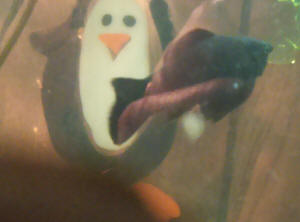
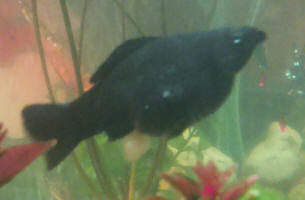 |
|
|

